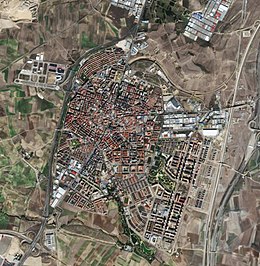Parla
This article needs additional citations for verification. (March 2009) |
Parla | ||
|---|---|---|
|
Postal code 28980–28984 | ||
| Official language(s) | Spanish | |
| Website | Official website | |
Parla (Spanish pronunciation: [ˈpaɾ.la]) is a municipality in the Community of Madrid, Spain. It is located in the southern part of the region, approximately 20 km from the capital, Madrid.
History

Origins
Earliest evidence of human occupation includes stone tools made of
During the 4th and 5th centuries, the ranks of the local populations swelled to include newly arrived
Independent local development was interrupted by the arrival of the Carthagineans and Romans, the latter of whom recorded the history of the pre-Roman villages of the area. Local Roman artifacts include a number of grave markers and coins.
After the
Modern times
The territory was part of the Alfoz of Madrid, a Spanish medieval territorial designation for the land surrounding a village during the Reconquista. At the time, there were two major villages in the area: Parla, to the north, and Humanejos to the south. Humanejos disappeared around the year 1650.
The first document to reference Parla is a letter which
After the Peninsular War, Parla became home to a large number of refugees from other localities. Around this time it achieves the status of township.
Politics and government

The current mayor is
The majority of local politics involves three of the major political parties: the Spanish Socialist Workers' Party (PSOE), the
During the
Local elections take place every four years, and are held in conjunction with the autonomous elections of the Community of Madrid. The next elections will take place in the year 2011.
The local government is divided into the following departments (called concejalía):
|
|
Location

The municipality of Parla covers an area of 24.43 km2. It borders six municipalities of the community of Madrid: Fuenlabrada to the North; Torrejón de Velasco and Torrejón de la Calzada to the South; Pinto to the East; and Griñón and Humanes de Madrid to the West.
Its elevation is 648.5 meters above sea level.
Demographics
Evolution
At the beginning of the 20th century, Parla had a population of 1,237. The municipality then underwent a population explosion, until reaching its current population of 150,000 (
The majority of population growth occurred during the late 1960s due to the major urban migration that was occurring in Spain at the time. Between 1960 and 1970, the population grew 470%, from 1,809 inhabitants to 10,317. This migration continued at an elevated rate during the 1970s, as people from
Starting in 1996, Parla once more began to experience a noticeable population growth, this time due to
People
- Javier Castillejo, boxer
- Juan José Ballesta, actor
- Cristina Sánchez, former bullfighter
- Rafael "Rafa" Benítez, football coach
- Iván Calero, football player
- Javier Camuñas Gallego, football player
- Javier Muñoz, football player
- José Ignacio Zahínos, football player
- Borja Mayoral, football player
Twin towns
 Callosa de Segura, Spain
Callosa de Segura, Spain Valladolid, Spain
Valladolid, Spain Funchal, Portugal
Funchal, Portugal Badalona, Spain
Badalona, Spain
See also
- Community of Madrid
- Iglesia gótico-mudéjar de Humanejos, demolished building near Parla
- Madrid metropolitan area
References
- ^ Municipal Register of Spain 2018. National Statistics Institute.
- ^ "Tomás Gómez: 'Ayer fue el día que más he llorado en mi vida" (in Spanish). El Mundo. 23 October 2008. Retrieved 11 March 2009.
- ^ "Resultados de las elecciones municipales de 2007". El País (in Spanish). 28 May 2007. Archived from the original on 31 May 2007. Retrieved 11 March 2009.








